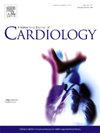Relative survival rate over twenty years of follow-up in younger patients with STEMI treated by primary percutaneous coronary intervention
IF 3.2
2区 医学
Q2 CARDIAC & CARDIOVASCULAR SYSTEMS
引用次数: 0
Abstract
Introduction
Primary percutaneous coronary intervention (pPCI) has been the gold standard treatment for patients with ST-elevation myocardial infarction (STEMI) in Europe for nearly two decades. While short- and medium-term outcomes are well described, data on very long-term mortality, especially in younger patients with longer life expectancy, remain limited.
Aim
To analyze very long-term mortality and 20 years relative survival rate compared to the general population in younger patients (≤65 years) with a first STEMI treated by pPCI.
Methods
We analyzed a high-volume, single-center registry of unselected STEMI patients treated with pPCI between January 1, 2000, and December 31, 2002. Patients aged ≤65 years with no history of myocardial infarction (MI) were selected. In cooperation with the Institute of Health Information and Statistics of the Czech Republic, we obtained mortality and cause-of-death data (classified by ICD-10) with a censoring date of December 31, 2023. Observed survival was assessed using the Kaplan–Meier method, and relative survival was estimated using the Pohar–Perme method, with expected survival derived from Czech national mortality tables.
Results
A total of 960 patients (71.4 % male, n = 686) with STEMI were treated with pPCI during the three-year study period. Among them, 385 patients (40.1 %) were ≤ 65 years with no previous MI. The mean age at STEMI was 55.03 ± 6.97 years for women (n = 71) and 54.16 ± 6.85 years for men (n = 314; p = 0.168). Over the entire very-long term follow-up period, 211 patients (54.8 %) died; cardiovascular causes were responsible in 111 cases (28.8 %). The 20-year overall survival was 50.6 %, while the 20-year relative survival was 79.5 %.
Conclusion
Despite high overall very-long term mortality in patients treated with primary PCI, the relative 20-year survival compared to the general population remained nearly 80 %. Furthermore, cardiovascular causes accounted for only half of all deaths.
经初级经皮冠状动脉介入治疗的年轻STEMI患者随访20年的相对生存率
近二十年来,原发性经皮冠状动脉介入治疗(pPCI)一直是欧洲st段抬高型心肌梗死(STEMI)患者的金标准治疗方法。虽然短期和中期结果已得到很好的描述,但关于长期死亡率的数据,特别是预期寿命较长的年轻患者的死亡率数据仍然有限。目的分析pPCI治疗首次STEMI的年轻患者(≤65岁)与一般人群相比的长期死亡率和20年相对生存率。方法:我们分析了2000年1月1日至2002年12月31日期间接受pPCI治疗的未选择STEMI患者的大容量单中心注册。患者年龄≤65岁,无心肌梗死(MI)病史。我们与捷克共和国卫生信息和统计研究所合作,获得了死亡率和死因数据(按ICD-10分类),审查日期为2023年12月31日。观察生存率采用Kaplan-Meier法评估,相对生存率采用Pohar-Perme法估计,预期生存率来源于捷克国家死亡率表。结果在3年的研究期间,共960例STEMI患者(男性71.4%,n = 686)接受了pPCI治疗。其中385例(40.1%)患者年龄≤65岁,既往无心肌梗死,STEMI时女性平均年龄为55.03±6.97岁(n = 71),男性平均年龄为54.16±6.85岁(n = 314; p = 0.168)。在整个长期随访期间,211名患者(54.8%)死亡;111例(28.8%)为心血管原因。20年总生存率为50.6%,20年相对生存率为79.5%。结论:尽管接受首次PCI治疗的患者的长期死亡率很高,但与一般人群相比,其20年的相对生存率仍接近80%。此外,心血管原因仅占所有死亡的一半。
本文章由计算机程序翻译,如有差异,请以英文原文为准。
求助全文
约1分钟内获得全文
求助全文
来源期刊

International journal of cardiology
医学-心血管系统
CiteScore
6.80
自引率
5.70%
发文量
758
审稿时长
44 days
期刊介绍:
The International Journal of Cardiology is devoted to cardiology in the broadest sense. Both basic research and clinical papers can be submitted. The journal serves the interest of both practicing clinicians and researchers.
In addition to original papers, we are launching a range of new manuscript types, including Consensus and Position Papers, Systematic Reviews, Meta-analyses, and Short communications. Case reports are no longer acceptable. Controversial techniques, issues on health policy and social medicine are discussed and serve as useful tools for encouraging debate.
 求助内容:
求助内容: 应助结果提醒方式:
应助结果提醒方式:


